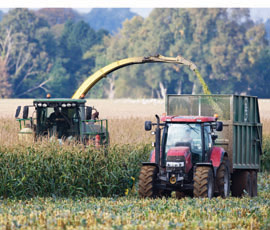More to biogas crops than yield per acre

Producers growing maize for biogas need to pay more attention to dry matter content rather than yield and tonnes an acre, Syngenta maize specialist Nigel Padbury said.
Speaking at the company’s recent maize trials near Mildenhall, which were hosted by The Shropshire Group, he said when considering varieties of maize for use in anaerobic digestion, growers should look at the results of UK trials, rather than those conducted in Europe.
He also told growers to fully consider the factors which influence biogas yield when comparing varieties. “What’s driving yield is not the net weight but the dry weight and the digestability of the starch. If you take the analogy of a unit of alcohol, you get the same amount from a unit of whisky or a unit of beer, but the beer has more volume. An energy rich silage is more analogous to whisky than beer,” said Mr Padbury.
In addition, metabolisable energy (ME) can provide a good indication of methane yield – information about this is available on the NIAB list, he said. “A correlation between ME and methane yield has been pretty well established by recent Dutch and German trials.”
Comparing two of the company’s maize varieties – NK Bull and MK Paddy, Mr Padbury said NK Bull, although not the tallest in the field, had an ME of 11.68 and would produce 214,000MJ/energy/ha. In contrast, MK Paddy was higher yielding with a higher dry matter content but lower ME, while producing a similar amount of energy/ha. “Paddy is more like your beer example, while Bull is like the whisky.”
Half of the energy supplied by the crop comes from the cob, with the rest coming from the stover, he added. “Behind the grains is a large chunk of rachis (stem) which is also a large quantity of energy. The cob gives a rapid energy boost so maize works well as a supplementary feedstock in biogas plants.”
When these factors are considered, the crop which produces the largest amount of green material in the field may not have the highest gas yield, especially when the financial and energy costs of harvesting, transportation and storage are considered. However, when growing a large area of the crop, growers will also need to choose varieties which provide a sufficiently long and flexible harvest window, said Mr Padbury.
Weed control trials
Syngenta technical manager Stephen Williams also provided an update on the company’s recent weed control trials in near Shippey Hill and Benacre in Suffolk. Pre-emergence sprays of Dual Gold (S-metolachlor) and Callisto (mesotrione) worked well on the lighter soil near the coast but were less effective on the rich organic soils. A contact application of 1.5 litres/ha of Callisto provided good control across a wide spectrum of weeds, although the addition of Samson Extra (nicosulfuron) is required where annual meadowgrass is present. “It’s interesting to see how much difference there is in the residual activity of these products when they are used on black soils,” said Mr Williams. “With more maize being grown for biogas in traditional vegetable production areas, we hope to run more herbicide trials next year to see what else is available to help growers deal with the following crop restrictions on mesotrione use, particularly on rented land.”
For more information on biogas visit our dedicated farm energy page
